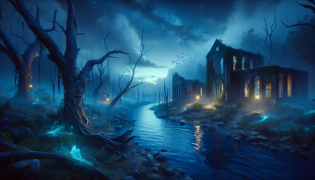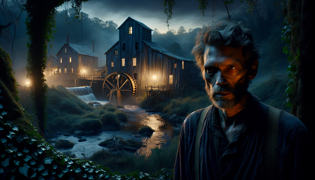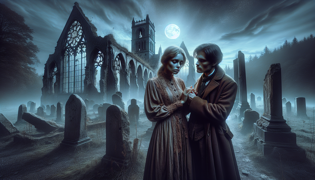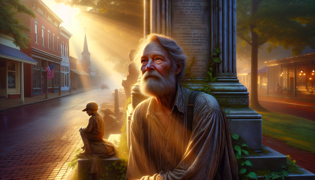The Mad Man: Brush Creek's Tale of Haunting Loss and Redemption
Reading Time: 16 min

About Story: The Mad Man: Brush Creek's Tale of Haunting Loss and Redemption is a Historical Fiction from united-states set in the Contemporary. This Dramatic tale explores themes of Loss and is suitable for Adults. It offers Entertaining insights. A spectral journey through a small town's hidden scars and hopeful healing.
Introduction
In the heart of Brush Creek, where the whispering winds echo with the memories of faded dreams, darkness and light entwine in the most unexpected of ways. The town, with its weather-beaten facades and silent, sprawling fields, holds secrets that few dare to speak of, and among these secrets is the legend of the Mad Man. Beneath a sky perpetually painted in shades of dusk, the creek’s gentle murmur blends with an undercurrent of sorrow and forgotten hope. Every brick and every leaf seems imbued with the tragic memories of those who once trod these paths, leaving behind imprints that time can neither erase nor forgive.
It is here, amid the desolation and the persistent ache of loss, that our troubled hero makes his solitary journey. Shunned by society and haunted by personal failures, he roams these lonely streets with a heavy heart burdened by the ghosts of his past. The townsfolk, wary of his eccentricities and the strange light that dwells in his eyes, often call him mad—a title that carries more than mere mockery, but the weight of collective despair. Yet, within his tormented soul lies a spark of unyielding determination, a quiet yearning for redemption.
As twilight descends and long shadows creep over crumbling sidewalks, Brush Creek itself seems to whisper of second chances. The environment sets the stage for a tale of intense emotions, where every step taken by the Mad Man is a step deeper into a labyrinth of memories, where loss and redemption are inextricably intertwined. The somber beauty of the landscape, with its gnarled trees and the persistent murmur of the creek, speaks to a timeless struggle—a struggle between the evils of regret and the hope of renewal.
Section 1: The Shadows of Brush Creek
The early evening in Brush Creek was a time when reality and specter seemed to blur, painting a canvas of sorrow and intrigue over the town’s every corner. In a tattered overcoat, with eyes that flickered like old film reels of forgotten tragedies, the Mad Man ambled along the abandoned railroad tracks that bisected the town. Born Elias to a family that once thrived in hope, he had been reduced to a wandering outsider—a ghost in a place that was itself a relic of better times. The roofs of the dilapidated houses sagged under the weight of neglect, and every sound, from the creak of a rusted sign to the whisper of wind through broken windows, seemed to speak of loss.
Elias’s mind was a maze of memories: the echo of his once-loving mother’s lullabies, the soft laughter of his childhood, and the sharp sting of irrevocable decisions that had led to the irrevocable loss of his beloved wife and unborn dreams. His transformation from a warm, promising man to the so-called ‘mad’ individual was not sudden—it was a slow, agonizing unraveling that mirrored the decay of Brush Creek itself. He recalled nights spent in anguished solitude near the creek, where the water’s gentle lull was a cruel mimicry of the love he had lost.
On this fateful evening, while the last vestiges of sunlight bled into the encroaching darkness, Elias found himself drawn to a place he had both avoided and secretly longed for: the old abandoned mill on the creek’s edge. Once a symbol of prosperity, the mill now stood as a crumbling monument to a time when hope was abundant. Its broken windows, like hollow eyes, stared out over the landscape, silently judging the passage of time and the frailty of human endeavors.
Inside this desolate structure, every surface was layered in dust and shadows. The remnants of machinery, twisted and bent by age, lay scattered like broken promises. It was here that Elias had often retreated to confront the phantoms of his past. In the dim, fading light, as he sat on a splintered beam, the ghostly murmurs of voices long silenced began to echo around him. They seemed to come from the very walls—voices of lost souls, each recounting tales of love, betrayal, and eternal regret. The oppressive atmosphere, heavy with sorrow, forced him to acknowledge that his journey was not simply one of isolation, but of confronting the deep scars that defined him.
The setting was as much a character as the man himself. Every rusted nail and spider web was a silent witness to the story of Brush Creek, a narrative of prosperity turned to ruin, of beauty marred by decay. As Elias traced his trembling fingers over a wall smeared by the passage of time, he felt the invisible weight of countless untold stories pressing upon him. In that static, mournful building, he began to understand that the madness attributed to him might instead be the clarity required to face an unbearable truth: that in loss, there is an echoing call towards healing, and in the darkest corners, the faint promise of redemption awaits those brave enough to listen.
Even as the nocturnal chill set in, the mill seemed to hum with a spectral energy—a reminder that even in desolation, life and hope could flicker in the most unexpected places. Elias’s eyes, though clouded by grief, held a glimmer of determination as he vowed silently to unearth the buried truth of his past. His journey along the shadowed trails of Brush Creek had only just begun, and the road ahead was as uncertain as the fate of the crumbling town itself.

Section 2: Echoes of the Past
As the cold night deepened its grasp on Brush Creek, Elias found himself tormented by memories too potent to dismiss. He recalled a time when the town buzzed with life, when laughter and love were not alien languages but the everyday refrain of a community united by hope. In painstaking flashbacks that wove seamlessly with the present, he remembered his childhood—a time when warm, golden afternoons and playful evenings had symbolized what he now sought desperately to regain.
Among his most vivid recollections was that of a bright summer day in which he, still a young man with dreams as endless as the horizon, met the love of his life. The memory was almost surreal in its beauty: laughing under the spreading arms of an ancient oak by the creek, exchanging shy glances while the sun danced over rippling waters. That day, the creek seemed to sing a lullaby of promise and possibility. But as fate would have it, a cruel twist transformed that idyll into a painful elegy. A terrible accident—a misfortune sparked by a chain of tragic events—tore away the heart of his world. His beloved was lost in a horrific misadventure, and with her departure went all semblance of innocence.
These echoes of bygone days were not merciful. The town itself, with its deserted streets and memories embedded in every crevice of its decaying architecture, seemed to remind him of what he had lost. In a quiet moment by the banks of the creek, as the water lapped gently against time-worn stones, Elias could almost hear her voice, soft and distant, carried on the wind. She had once been his guiding star, a symbol of all that was good and beautiful in a seemingly indifferent world. The juxtaposition of joyful recollection and present sorrow was jarring. The very same creek that had once nurtured life now bore silent witness to his grief and the irreversible transformation of his soul.
Wandering further through the night, Elias ventured to forgotten sites in Brush Creek that had once been filled with laughter—the old diner where locals had gathered, the tiny park where children had played, and even the decaying remnants of a once-thriving theater. Each site stirred up layers of love, pain, and regret, intertwining the past with his sorrowful present. In these spectral visits, the boundaries of time blurred; the faces of those who had vanished appeared translucent against the backdrop of moonlit ruins. With every step, Elias felt the magnetic pull of accountability—a need to atone for the mistakes that had led him here.
In a particularly stirring moment, standing beneath a flickering street lamp, he encountered a crumpled letter left behind in a narrow alley, its ink smudged by rain and time. The letter was a fragment of memory—a message of farewell, a testament to lost hope and yearning for forgiveness. The words etched on the paper seemed to murmur, urging him to seek out the truth buried deep within his own heart. It was as if the past was beckoning him towards a resolution that had long been delayed. The profound interplay of memory and remorse became a catalyst, compelling him to reckon with the reality that only by embracing every painful recollection could he begin to forge a new path. Upon that rain-slicked pavement, Elias resolved that tonight, haunted by echoes of a life now past, he would finally step toward the light of redemption—no matter how forlorn the journey appeared.
In the dark corridors of his mind and in the silent testimony of Brush Creek’s abandoned relics, the weight of history pressed heavily upon him. And yet, even in the midst of overwhelming sorrow, a fragile seed of hope stirred—a reminder that every ending could herald a new beginning, a truth that the past, with all its agonies, might just pave the way for redemption.

Section 3: Whispers in the Dark
The oppressive stillness of the night was broken only by sporadic murmurs that seemed to emanate from the very soul of Brush Creek. As Elias advanced further into the labyrinth of his memories and the town’s decaying corners, an enigmatic presence made itself known. Late one night, while navigating an overgrown pathway flanked by ancient oaks whose branches clawed at the starry sky, he encountered a figure draped in shadow. This mysterious woman, whose eyes shone with both sorrow and an indefinable knowing, appeared almost as if summoned by his silent pleas.
Her name, whispered on the wind and carried on the lips of local lore, was Marian. Unlike the fleeting phantoms of his past, Marian embodied a tangible warmth—a bittersweet reminder that not all darkness was without hope. She claimed to be a keeper of the lost tales of Brush Creek, entrusted with the duty to guide those steeped in grief towards understanding and, ultimately, redemption. Marian’s presence was ethereal yet grounding; her soft-spoken words carried a melody that calmed Elias’s turbulent thoughts. In her quiet, deliberate manner, she suggested that every fractured soul in Brush Creek had a purpose, that every misfortune was also an opportunity for rebirth.
Throughout that lonely night, as the duo wandered amidst ruins and relics of a once-vibrant community, Marian recounted stories of bygone residents whose lives had been irrevocably altered by fate. Her voice, both tender and resolute, spoke of forgiveness earned through trials and penance met with resilience. With every tale, the oppressive gloom seemed to lighten, as if the very fabric of the night was yielding to the possibility of renewal. Elias listened intently, each word building bridges across the chasm of his isolation.
Together, they stopped by the remnants of an old chapel. Wood and stone, worn by centuries of neglect, provided shelter for the whispered confessions of the past. Here, in the sanctity of sacred ruins, Marian encouraged Elias to confront the dark secrets that had long imprisoned him. Under the ghostly glow of a waning moon, the stained glass windows—though shattered—cast fragmented rainbows across the floor. In this interplay of light and shadow, Elias began to see that his sorrow, although vast, was not an end but a beginning.
Marian’s gentle guidance stirred something dormant within him. Her words were a balm to wounds that had festered in solitude, and as they sat together beneath the flickering remains of stained glass, Elias found strength in vulnerability. The whispers in the dark, once harbingers of fear, transformed under her influence into catalysts for introspection and growth. In that moment, the mournful cadence of Brush Creek’s nighttime symphony receded, replaced by the soft, steady pulse of a heart determined to seek absolution. That night, amidst spectral ruins and tender revelations, Elias understood that every ghost from his past held a lesson—a crucial step on the arduous path to self-forgiveness and unburdening the soul.
The journey through the dark corridors of memory and neglect was neither linear nor simple. Yet, with Marian at his side, the inscrutable whispers of Brush Creek evolved from accusatory voices into gentle reminders that redemption, though elusive, was attainable through acceptance and heartfelt repentance. The night, in its mysterious ways, offered not just isolation and despair but also the promise that even the most haunted of souls could one day find peace.

Section 4: A Journey Towards Light
In the final throes of a long, meandering night, Brush Creek began to stir with the first hints of dawn. As the horizon lightened, so too did the weight of the shadows that had long haunted Elias. The journey toward redemption, while paved with relentless memories and painful introspection, now shimmered with the promise of renewal. With Marian’s parting words echoing in his mind, he resolved to confront the remnants of grief that had chained him to a past he no longer wished to endure.
At the break of day, Elias made his way to the heart of Brush Creek—the old town square, where a massive, timeworn statue of a once-revered founding figure stood as a solemn reminder of the community’s proud beginnings. Here, amid the soft golden light of morning and with the tender murmur of the awakening town around him, he initiated a ritual of remembrance and absolution. One by one, he visited the silent memorials scattered across Brush Creek: the neglected cemetery with marble headstones cracked by the passage of time, the dilapidated schoolhouse echoing with faded laughter, and the remnants of his own once cherished home.
Each step was a pilgrimage—a melancholic yet liberating surrender to the inevitable cycle of loss and rebirth. Elias began to write down the names and stories of those he had lost and even those he had wronged, carefully stitching together the tapestry of his personal history into a testament to both suffering and the resilience of the human spirit. In this act of laborious catharsis, the boundaries between past and present blurred, transforming the somber ritual into a celebration of life’s enduring capacity to heal.
The morning sun ascended higher, its rays piercing through the veil of night, and with it came a newfound clarity. Elias felt a stirring within, a hope ignited not by naivety, but by the profound understanding that redemption was less about erasing the scars of the past and more about embracing them as markers of a life fully lived. It was in that sincere, vulnerable acceptance that he found a measure of peace.
Even as Brush Creek slowly awakened, its derelict structures and quiet streets bore silent witness to a metamorphosis—a transformation that was not of the physical, but of the spirit. Elias, once the man burdened by madness and regret, now emerged as a figure of introspection and quiet strength, ready to rebuild not the town of his memories, but his own fractured soul. In the interplay of gentle morning light and lingering shadows, he was reborn, promising himself that every day henceforth would be a testament to the power of redemption and the relentless pursuit of inner peace.
As the day unfolded and the echoes of the past gradually gave way to the conservatory hum of new beginnings, Brush Creek itself seemed to sigh in relief. The ancient scars of the town, like those borne by Elias, would never entirely vanish; yet, in their very existence, they now also spoke of survival and grace. In this transcendent moment, the journey towards light was complete—not as an end, but as a continuum of hope, healing, and an abiding, if fragile, resilience.

Conclusion
In the final analysis, the chronicle of Elias—once shunned as the Mad Man—evolved into a resonant narrative about the power of confronting one’s past and the possibility of renewal. As Brush Creek slowly stirred from its prolonged slumber of despair, the once-cursed streets began to hum with the subtle notes of rebirth. The numerous echoes of tragedy that had once defined both the town and its solitary wanderer were now being transmuted into lessons of compassion, accountability, and a hard-won hope.
Standing amid the relics of decayed grandeur and whispered memories, Elias embraced the tender imperfection of his existence. His pilgrimage through sorrow had taught him that every scar carried its own story—a reminder that love, loss, and regret are intertwined chapters in the epic of life. With each step forward, he let go of the heavy mantle of guilt and sorrow that had once defined him, choosing instead to honor the past by living a life that celebrated recovery and human resilience. In the eyes of the town’s few remaining believers, he was no longer solely the mad man of old but a living symbol of redemption—a man who had dared to face the darkness and emerge with a gentle, quiet strength.
As the day gave way to an inevitable dusk, Elias looked out at Brush Creek with a serene acceptance. He knew that his journey was far from over, and that each new sunrise would bring with it struggles worthy of remembrance. Yet, amid all uncertainty, one truth remained: the intertwined legacies of loss and redemption were as much a part of him as were the memories of both love lost and love found. In this bittersweet convergence of despair and hope, the story of Brush Creek and its haunted wanderer continued—a story that would inspire those willing to accept the full breadth of life’s shadows and light.
Thus, beneath skies that carried both the stains of past sorrows and the promise of new beginnings, the tale of the Mad Man was etched into the annals of Brush Creek, a timeless reminder that even in the direst moments, the human spirit retains the capacity to find, nurture, and ultimately be reborn in the radiant glow of redemption.
















